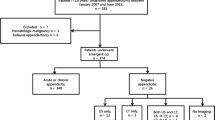Abstract
Background
The optimal treatment of perforated appendicitis remains controversial, but there is a trend toward nonoperative management. CT scanning might be helpful in determining which patients could benefit from this treatment option.
Objective
To determine the value of CT imaging in predicting clinical success or failure in children with nonoperative management of perforated appendicitis.
Materials and methods
Admission CT scans of 34 children with perforated appendicitis treated nonoperatively between January 2003 and June 2006 were retrospectively reviewed. All children were given intravenous antibiotics. Clinical outcome was correlated with imaging findings including the maximal area, number and complexity of collections, presence of an appendicolith or extraluminal air, and extent of intra-abdominal disease outside the right lower quadrant. Patients with an accessible simple collection were drained if their clinical condition did not improve.
Results
Successful nonoperative management was achieved in 20 patients; 14 patients failed nonoperative therapy. The presence of collections in three or more sectors (defined as the pelvis and four abdominal quadrants) correlated strongly with clinical failure (P < 0.05), while there was no correlation found between clinical outcome and the presence of an appendicolith, extraluminal air, distant ascites, and collection size or complexity.
Conclusion
In the nonoperative management of children with perforated appendicitis, admission CT findings demonstrating disease beyond the right lower quadrant correlate with treatment failure.




Similar content being viewed by others
References
Weber TR, Keller MA, Bower RJ et al (2003) Is delayed operative treatment worth the trouble with perforated appendicitis in children? Am J Surg 186:685–688
Oliak D, Yamini D, Udani VM et al (2001) Initial non-operative management for periappendiceal abscess. Dis Colon Rectum 44:936–941
Vargas HI, Averbook A, Stamos MJ (1994) Appendiceal mass: conservative therapy followed by interval laparoscopic appendectomy. Am J Surg 60:753–758
Skoubo-Kristensen E, Hvid I (1982) The appendiceal mass: results of conservative management. Ann Surg 196:584–587
Kogut KA, Blakely ML, Schropp KP et al (2001) The association of elevated percent bands on admission with failure and complications of interval appendectomy. J Pediatr Surg 36:165–168
Keyzer C, Tack D, de Maertelaer V et al (2004) Acute appendicitis: comparison of low-dose and standard-dose enhanced multi-detector row CT. Radiology 232:164–172
Callahan MJ, Rodriguez DP, Taylor GA (2002) CT of appendicitis in children. Radiology 224:325–332
Taylor GA, Callahan MJ, Rodriguez D et al (2006) CT for suspected appendicitis in children: an analysis of diagnostic errors. Pediatr Radiol 36:331–337
Rodriguez DP, Vargas S, Callahan MJ et al (2006) Appendicitis in young children: imaging experience and clinical outcomes. AJR 186:1158–1164
Jaffe BM, Berger DH (2005) The appendix. In: Brunicardi FC, Andersen DK, Billiar TR et al (eds) Schwartz’s principles of surgery, 8th edn. McGraw-Hill, New York, pp 1119–1137
McPherson A, Kinmonth J (1945) Acute appendicitis and the appendix mass. Br J Surg 32:365–370
Brown CVR, Abrishami M, Muller M et al (2003) Appendiceal abscess: immediate operation or percutaneous drainage? Am J Surg 69:829–832
Erdogan D, Karaman I, Narci A et al (2005) Comparison of two methods for the management of appendicular mass in children. Pediatr Surg Int 21:81–83
Nadler EP, Reblock KK, Vaughan KG et al (2004) Predictors of outcome for children with perforated appendicitis initially treated with non-operative management. Surg Infect 5:349–356
Bufo AJ, Shah RS, Li MH et al (1998) Interval appendectomy for perforated appendicitis in children. J Laparoendosc Adv Surg Tech A 8:209–214
Hormann M, Kreuzer S, Sacher P et al (2001) Abscesses after appendectomy due to intra-operative retaining of fecalith. Rofo 173:720–723
Tsai H, Shan Y, Lin P et al (2006) Clinical analysis of the predictive factors for recurrent appendicitis after initial non-operative treatment of perforated appendicitis. Am J Surg 192:311–316
Jamieson DH, Chait PG, Filler R (1997) Interval drainage of appendiceal abscesses in children. AJR 169:1619–1622
Author information
Authors and Affiliations
Corresponding author
Rights and permissions
About this article
Cite this article
Levin, T., Whyte, C., Borzykowski, R. et al. Nonoperative management of perforated appendicitis in children: can CT predict outcome?. Pediatr Radiol 37, 251–255 (2007). https://doi.org/10.1007/s00247-006-0384-y
Received:
Revised:
Accepted:
Published:
Issue Date:
DOI: https://doi.org/10.1007/s00247-006-0384-y




